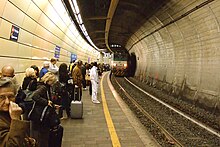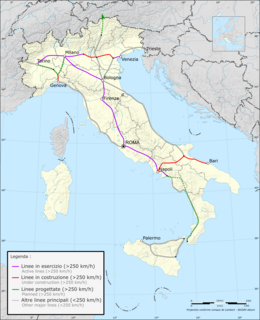
Ferrovie dello Stato Italiane S.p.A. is Italy's national state-owned railway holding company that manages transport, infrastructure, real estate services and other services in Italy and other European countries.

The Naples Metro is the rapid transit system serving the city of Naples, Italy. The system comprises three underground rapid transit lines.

The FS E.625 and E.626 are two classes of Italian electric locomotives produced for the Ferrovie dello Stato. They were introduced in the course of the 1920s and remained in service until the 1990s. The E.626 was the first locomotive fed by 3,000 V DC overhead line in Italy.

Line 2 is a rapid transit service operated by Trenitalia in the city of Naples, Italy. It connects 12 stations.

Genova Piazza Principe railway station is the central station of Genoa and is located on Piazza Acquaverde, occupying the entire north side of Via Andrea Doria—where the station entrance is located—in the town centre and a short distance from the Palazzo del Principe, from which it takes its name. It is used by about 66,000 passengers per day and 24,000,000 per year. The first temporary station was opened in 1854 at the end of the line from Turin. Lines were later opened to Milan, Rome and the French border at Ventimiglia.

The Genoa–Pisa railway is one of the trunk lines of the Italian railway network. It runs along the Ligurian coast from Genoa to Pisa through the Riviera di Levante and the Versilia. It passes through the cities of Massa, Carrara and La Spezia. South of Pisa the Pisa–Rome line continues along the Tyrrhenian coast to Rome. The line is double track and is fully electrified at 3,000 V DC. Passenger traffic is managed by Trenitalia.
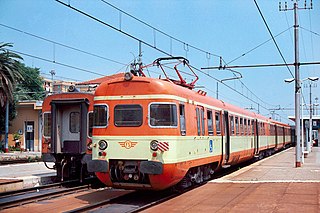
The ALe 801/940 are a series of EMUs built in the 1970s for the Italian state railway FS, now used by its successor, Trenitalia.
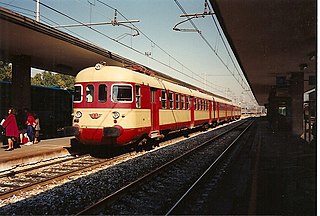
The ALe 803 are a series of EMUs built in the 1960s for the Italian state railways FS, and now used by the railway company Trenitalia.
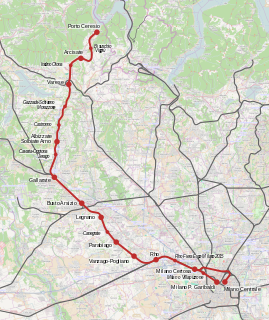
Porto Ceresio–Milan railway is a railway line in Lombardy, Italy. It uses the tracks of the Milan–Arona railway until Gallarate.

The ALe 724 are a class of EMUs of the Italian Ferrovie dello Stato, projected for suburban and regional services.

The Ferrovie dello Stato Italiane Class 940 is a 2-8-2 steam tank locomotive, derived from the Class 740 tender locomotive.
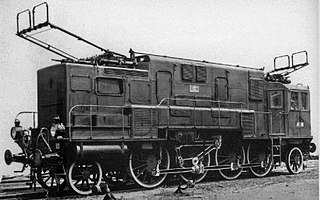
The FS Class E.471 locomotives were prototype three-phase AC electric locomotives designed for the Italian State Railways (FS). They constituted the first Italian experiment in using a phase converter. The final goal was to power them with single-phase alternating current, constituting the first case of a European locomotive of this type designed according to modern criteria. However, the difficulty of the development, and political interference, led to the abandonment of the project.

The FS Class E.431 was a class of three-phase AC electric locomotives of the Italian State Railways (FS).

FS Class E.432 was a class of three-phase electric locomotives of the Italian State Railways. Forty of these 1′D1′ locomotives were built in 1928 by Società Ernesto Breda and two have been preserved.
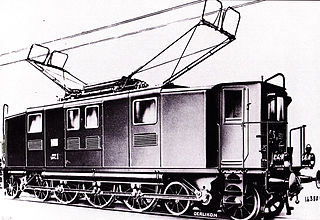
FS Class E.332 was a class of three-phase electric locomotives of the Italian State Railways (FS). They were used for the haulage of passenger trains between 1917 and 1963. Designed and built at the same time as the FS Class E.331, they represented an attempt by FS to extend the use of three-phase AC electric traction from primary to secondary routes. Their performance was disappointing and they were relegated to a marginal role, in which they remained despite several modifications.

FS Class E.333 was a class of electric locomotives of the Ferrovie dello Stato (FS), powered by three-phase alternating current, which were in service from 1923 to 1968. They were designed by Kálmán Kandó for hauling fast passenger trains. Having the same electrical equipment as the FS Class E.552 locomotives, they presented the same defects and had to be modified. After modification, they were able to carry out the services for which they were designed.
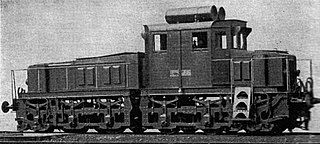
The FS Class E.620 was a class of third-rail electric locomotives built by Officine Meccaniche Reggiane for the Italian State Railways (FS). They were built in 1925 using motors and electrical equipment from Class E.10 railcars which had been withdrawn in 1923. After World War II they were converted to 3,000 volt DC operation and became FS Class E.621.
The FS Class E.621 was a class of five electric locomotives of the Italian State Railways (FS). They were rebuilt in 1947 from FS Class E.620, which was originally built in 1925. The main change was conversion from 650 V DC third rail to 3,000 V DC overhead line power supply.

FS Class 400 were steam locomotives of French construction, built for service in Italy. They were 0-8-0 tender locomotives with two outside cylinders.

Riccardo Bianchi (1854-1936) was an Italian engineer and the first Director-General of the Italian State Railways (FS), formed in 1905.
